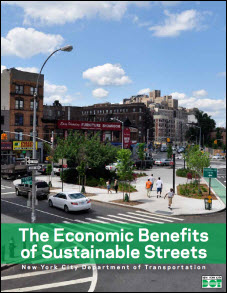 New York City Department of Transportation (NYCDOT) recently released "The Economic Benefits of Sustainable Streets." The study develops a set of metrics for assessing the local economic impact of street improvement projects intended to create "complete streets," which are safe, accessible, convenient, and comfortable for all users. The types of projects evaluated using the newly developed metrics included corridors and intersections reconstructed to include parking-protected bike lanes, landscaping and planted medians, widened sidewalks, pedestrian refuge islands, plazas, curbside management (new parking regulations) and dedicated bus lanes (Select Bus Service routes), along with other multi-modal access, mobility, and safety enhancements.
New York City Department of Transportation (NYCDOT) recently released "The Economic Benefits of Sustainable Streets." The study develops a set of metrics for assessing the local economic impact of street improvement projects intended to create "complete streets," which are safe, accessible, convenient, and comfortable for all users. The types of projects evaluated using the newly developed metrics included corridors and intersections reconstructed to include parking-protected bike lanes, landscaping and planted medians, widened sidewalks, pedestrian refuge islands, plazas, curbside management (new parking regulations) and dedicated bus lanes (Select Bus Service routes), along with other multi-modal access, mobility, and safety enhancements.
In seven case studies, the report compares aggregated, local business sales data (retail and food trades) from "improvement sites" with nearby "comparison sites" in order to track the local economic impact of the improvements. The study concludes that high quality, multimodal, people-oriented streets and public spaces provide substantial economic benefits and that street design should be added to cities' economic development strategies.